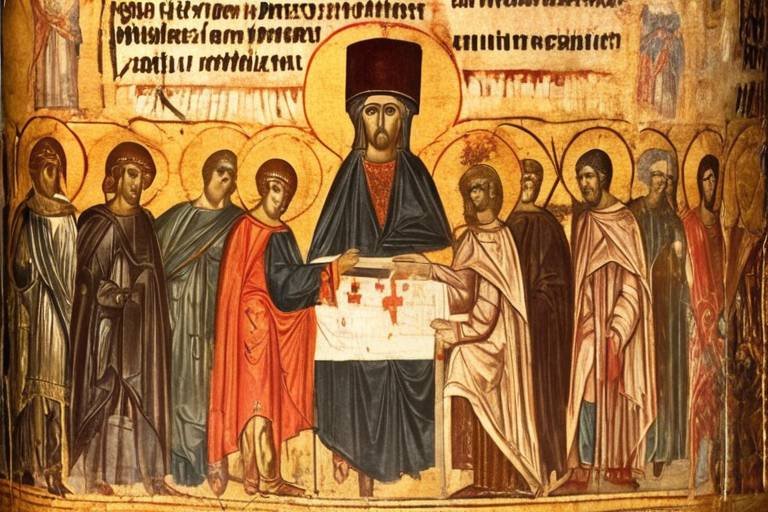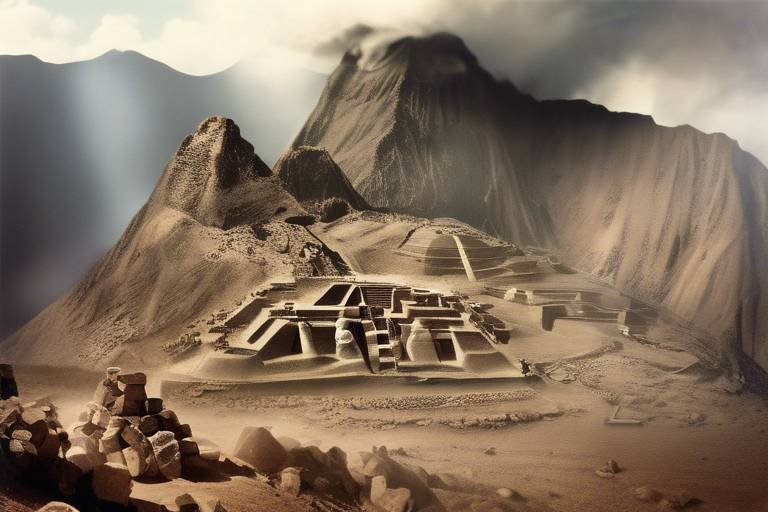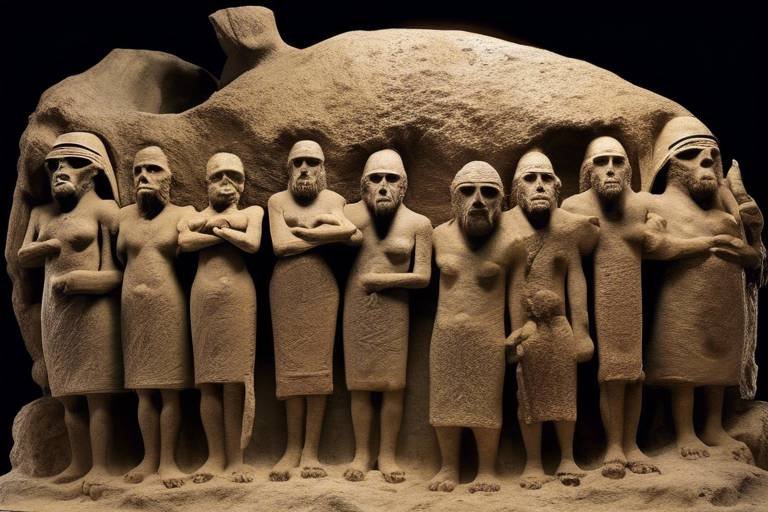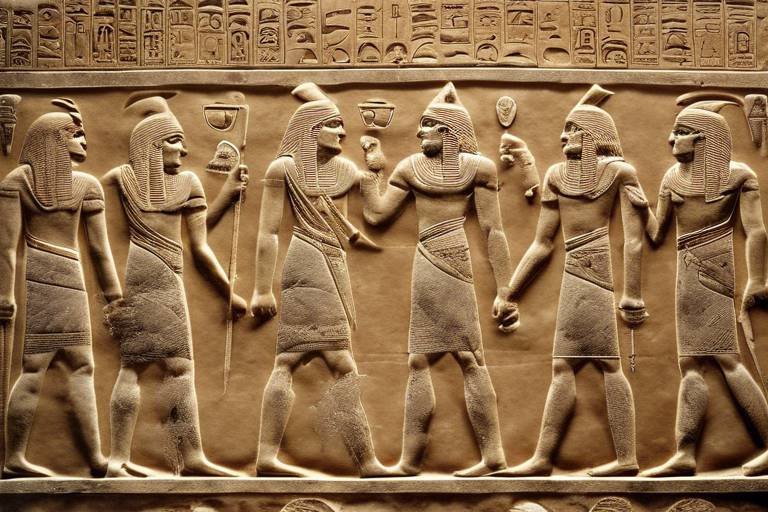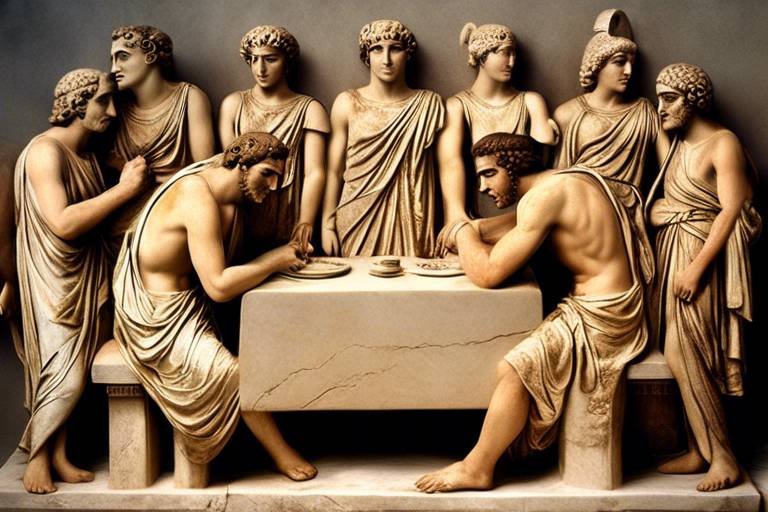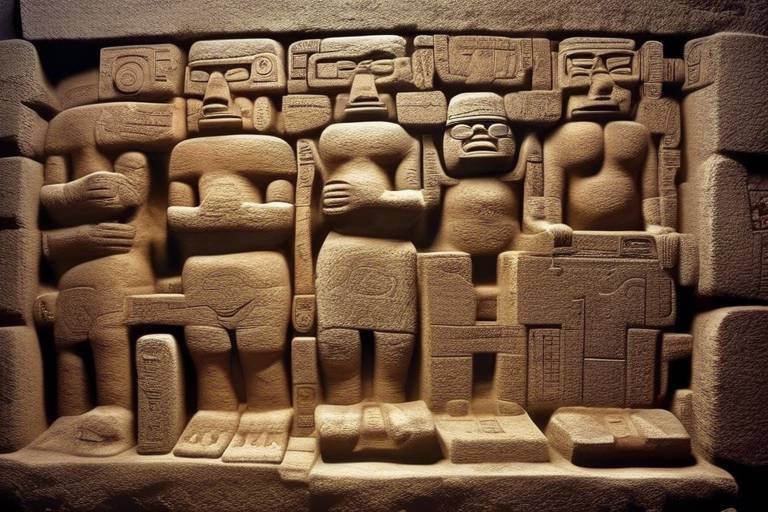The Secrets of the Olmec Civilization's Rituals
The Olmec civilization, one of the oldest and most enigmatic cultures in Mesoamerica, holds a treasure trove of secrets within its intricate rituals. These ancient practices offer a glimpse into a world where art, symbolism, and spirituality intertwined to create a rich tapestry of beliefs and traditions. Delving into the mysteries of the Olmec rituals unveils a fascinating journey through time, where ceremonial practices played a central role in shaping the society and worldview of this enigmatic civilization.

Introduction to the Olmec Civilization
The Olmec civilization, considered one of the earliest complex societies in Mesoamerica, flourished between 1400 and 400 BCE in what is now modern-day Mexico. Known for their advanced cultural practices and artistic achievements, the Olmec people laid the foundation for many aspects of later Mesoamerican civilizations. Their influence can be seen in various aspects of art, religion, and society, making them a pivotal civilization in the region's history.
At the heart of Olmec society was a rich tapestry of rituals and ceremonies that played a crucial role in their daily lives. These rituals were deeply intertwined with their religious beliefs and cultural practices, shaping the way they interacted with the spiritual world and each other. Through intricate ceremonies and symbolic gestures, the Olmec sought to maintain harmony with the divine forces they believed governed the universe.
Artistic expression was a central component of Olmec rituals, with intricate sculptures, carvings, and pottery serving as vessels for their spiritual beliefs. These artistic representations often depicted deities, mythological creatures, and symbolic motifs that held significant meaning in Olmec cosmology. The intricate details and craftsmanship of these artworks reflected the Olmec's reverence for the divine and their commitment to honoring the spiritual realm through visual storytelling.
As we delve into the mysteries of the Olmec civilization's rituals, we uncover a world where symbolism played a crucial role in communicating complex ideas and beliefs. The symbols and iconography found in Olmec art and rituals were not merely decorative but held profound meanings that connected the physical and spiritual realms. By deciphering these symbols, archaeologists have gained valuable insights into the Olmec worldview and the significance of their ritual practices.
Through archaeological discoveries, researchers have unearthed a treasure trove of artifacts that offer glimpses into the religious practices and beliefs of the Olmec civilization. From elaborate ceremonial centers to intricate burial sites, these findings provide valuable clues about the rituals and ceremonies that defined Olmec society. By piecing together these archaeological puzzles, we can reconstruct the vibrant tapestry of Olmec rituals and shed light on their cultural significance.
The Olmec pantheon of gods and goddesses played a central role in their religious rituals, with deities representing various aspects of nature, fertility, and the supernatural. These divine beings were worshipped through elaborate ceremonies and offerings, symbolizing the Olmec's reverence for the forces that governed the natural world. By exploring the religious beliefs and practices of the Olmec, we gain a deeper understanding of their spiritual worldview and the rituals that shaped their daily lives.
Sacrificial offerings were a common practice in Olmec rituals, with offerings of food, animals, and even human sacrifices made to appease the gods and ensure the well-being of the community. These rituals were seen as essential for maintaining balance and harmony in the world, with sacrifices serving as a powerful means of communication with the divine. The practice of sacrifice was deeply ingrained in Olmec society, reflecting their belief in the interconnectedness of all living beings.
Ceremonial sites and structures were integral to Olmec rituals, serving as sacred spaces where the community gathered to perform religious ceremonies and pay homage to their gods. These sites were often adorned with intricate carvings, altars, and monuments that reflected the spiritual significance of the rituals performed there. By examining the design and purpose of these ceremonial structures, we can gain valuable insights into the religious practices and beliefs of the Olmec civilization.
As we unravel the intricate tapestry of Olmec ritualistic practices and ceremonies, we discover a world filled with mystery, symbolism, and spiritual significance. From elaborate processions to sacred dances, these rituals were a central aspect of Olmec society, shaping the way they viewed the world and interacted with the divine. By exploring the details of these rituals, we can gain a deeper appreciation for the complexity and sophistication of Olmec culture.
The legacy of Olmec rituals continues to resonate in the cultural practices of subsequent Mesoamerican civilizations, influencing the way they approach religion, art, and society. The enduring impact of Olmec rituals serves as a testament to the richness and complexity of their cultural heritage, highlighting the lasting contributions they made to the development of Mesoamerican civilization. By studying the rituals of the Olmec, we can gain valuable insights into the spiritual beliefs and practices that shaped the ancient world and continue to inspire us today.

Artistic Representations in Rituals
Art played a central role in the rituals of the enigmatic Olmec civilization, serving as a powerful medium for spiritual expression and communication with the divine. The Olmec people were masterful artisans, creating intricate and symbolic artworks that conveyed profound meanings within their ritual practices.
One of the most iconic artistic representations in Olmec rituals is the colossal stone heads that have captivated archaeologists and art enthusiasts alike. These monumental sculptures, carved with meticulous detail, are believed to depict revered leaders or deities, embodying the spiritual essence of the Olmec civilization.
Moreover, the Olmec excelled in the creation of jade figurines, intricately crafted with precision and imbued with symbolic significance. These precious artifacts were likely used in sacred ceremonies, symbolizing the connection between the earthly realm and the spiritual realm in Olmec belief systems.
The use of art in Olmec rituals extended beyond sculptures and figurines, encompassing intricate pottery adorned with symbolic motifs and vibrant colors. These vessels were not merely utilitarian objects but sacred items used in ceremonial contexts, reflecting the Olmec's reverence for the divine in their everyday rituals.
Through their artistic expressions, the Olmec conveyed their spiritual beliefs, cosmological concepts, and ritual practices with a sophistication that continues to intrigue modern scholars. The intricate details and symbolic richness of Olmec art offer a window into the mystical world of this ancient civilization, where art and ritual intertwined to create a profound spiritual experience.

Symbolism in Olmec Rituals
The Olmec civilization, known for its enigmatic rituals, was deeply intertwined with symbolism that permeated every aspect of their religious practices. Symbolism in Olmec rituals played a crucial role in conveying profound meanings and connecting the physical world with the spiritual realm. The Olmec people utilized a rich array of symbols and iconography in their ceremonies, each carrying layers of significance that reflected their beliefs and worldview.
One of the most prominent symbols in Olmec rituals was the jaguar, a powerful and revered animal that symbolized strength, agility, and the supernatural. Depicted in various forms of art and sculptures, the jaguar was believed to possess spiritual qualities and serve as a guardian of the sacred spaces where rituals took place. The presence of jaguar imagery in Olmec rituals signified a connection to the spirit world and the embodiment of divine forces.
Another significant symbol in Olmec rituals was the cacao tree, which held deep cultural and religious importance for the Olmec people. Cacao beans were used in ritual offerings and ceremonies, symbolizing fertility, abundance, and divine sustenance. The cacao tree was associated with the gods and seen as a bridge between the earthly realm and the supernatural, highlighting the Olmec's reverence for nature and the cycles of life.
The use of masks in Olmec rituals also carried symbolic meanings, representing transformation, spiritual transcendence, and the channeling of ancestral spirits. Masks were worn by priests and participants during ceremonies to embody different deities or beings, allowing them to communicate with the divine world and enact sacred rituals. The intricate designs and symbolism embedded in these masks conveyed the complex cosmology and spiritual beliefs of the Olmec civilization.
Moreover, the Olmec's use of jade, a precious stone with symbolic significance, in their rituals reflected their reverence for the natural world and the divine forces believed to reside within the material realm. Jade artifacts, such as figurines and ornaments, were used in ceremonial contexts to symbolize power, purity, and spiritual connection. The intricate carvings and symbolism associated with jade objects underscored the Olmec's spiritual sophistication and artistic mastery.
In conclusion, the symbolism embedded in Olmec rituals served as a symbolic language through which the ancient civilization expressed its cosmological beliefs, spiritual practices, and cultural identity. The intricate symbols and iconography found in Olmec art and rituals continue to fascinate archaeologists and researchers, offering valuable insights into the rich and complex world of this enigmatic Mesoamerican culture.

Archaeological Discoveries
Exploring the origins and significance of the Olmec civilization in Mesoamerica and their cultural practices, one cannot overlook the fascinating archaeological discoveries that shed light on their intricate rituals. These discoveries provide a window into the past, offering valuable insights into the beliefs and practices of this ancient civilization.
Archaeological excavations in various Olmec sites have unearthed a treasure trove of artifacts that offer clues to the rituals and ceremonies of this enigmatic civilization. Among the most significant discoveries are the colossal stone heads, intricately carved jade figurines, and elaborate offerings found in ceremonial contexts.
The presence of colossal stone heads, some weighing several tons, suggests a deep reverence for rulers or deities within the Olmec society. These impressive sculptures, with distinct facial features and headdresses, are believed to represent powerful individuals or divine beings central to Olmec religious beliefs.
Furthermore, the discovery of intricately carved jade figurines points to the importance of ritual objects in Olmec ceremonies. Jade, a precious stone highly valued by the Olmec, was often used in the creation of symbolic artifacts associated with religious practices, emphasizing the spiritual significance of these rituals.
Additionally, the uncovering of elaborate offerings, such as ceramic vessels, figurines, and ritual tools, provides valuable insights into the sacrificial practices and ceremonial traditions of the Olmec. These offerings, carefully placed in ritual contexts, highlight the importance of ritualistic activities in the daily life of the Olmec people.
Through these archaeological discoveries, researchers have been able to piece together a more comprehensive understanding of the rituals and beliefs that shaped the Olmec civilization. Each artifact serves as a puzzle piece in unraveling the mysteries of this ancient culture, allowing us to glimpse into the spiritual world of the Olmec people.

Religious Beliefs and Deities
Religious beliefs and deities held a central role in the spiritual practices of the Olmec civilization. The Olmec people worshipped a pantheon of gods and goddesses, each representing different aspects of nature, fertility, and the cosmos. Among the most prominent deities in Olmec religion were the Maize God, associated with agriculture and sustenance, and the Feathered Serpent, a symbol of renewal and transformation.
The Olmec believed in the interconnectedness of the spiritual and physical worlds, viewing rituals as a means of maintaining harmony and balance in the universe. Their religious ceremonies often involved elaborate offerings and sacrifices to appease the gods and ensure the prosperity of their communities. These rituals were conducted in sacred spaces such as temples and pyramids, where priests and shamans performed intricate ceremonies to communicate with the divine.
Art played a significant role in expressing the Olmec's religious beliefs, with sculptures and carvings depicting deities and mythological scenes. The colossal stone heads, believed to represent powerful rulers or deities, are iconic symbols of Olmec artistry and religious devotion. These artworks served not only as representations of the gods but also as conduits for spiritual energy and protection.
Symbolism permeated every aspect of Olmec rituals, with intricate designs and motifs carrying deep spiritual meanings. The jaguar, for example, was a sacred animal associated with power and transformation, often depicted in ceremonial contexts as a symbol of strength and agility. The use of jade, a precious stone believed to have mystical properties, further underscored the spiritual significance of Olmec religious practices.
Through their religious beliefs and rituals, the Olmec sought to forge a connection with the divine forces that governed the natural world. Their reverence for the gods and goddesses, expressed through art, symbolism, and ceremonial practices, reveals a profound spiritual worldview that continues to intrigue and inspire scholars and enthusiasts alike.

Sacrificial Offerings
Sacrificial offerings were a central aspect of Olmec rituals, playing a significant role in their religious practices. The Olmec people believed that offering sacrifices to their deities was essential for maintaining harmony and balance in the world. These offerings varied from simple items like food and pottery to more elaborate offerings such as precious stones and figurines. The act of sacrifice was seen as a way to communicate with the gods and seek their favor for bountiful harvests, protection from disasters, and overall well-being of the community.
Archaeological excavations have uncovered various artifacts and remnants related to sacrificial practices, providing valuable insights into the beliefs and customs of the Olmec civilization. The sacrificial offerings were often placed in sacred spaces within ceremonial sites, highlighting the importance of these rituals in the Olmec society. The choice of offerings and the manner in which they were presented reflected the spiritual connection the Olmec people had with their deities.
Moreover, sacrificial ceremonies were not limited to material offerings but also included ritualistic practices such as bloodletting and human sacrifices. These acts were believed to appease the gods and ensure the well-being of the community. The Olmec's willingness to make such sacrifices demonstrates the depth of their religious convictions and the lengths they were willing to go to honor their deities.
Through the study of sacrificial offerings and rituals, researchers have gained valuable insights into the religious beliefs and practices of the Olmec civilization. These practices not only shaped the spiritual landscape of the Olmec society but also influenced the development of subsequent Mesoamerican cultures. The legacy of sacrificial offerings in Olmec rituals serves as a testament to the enduring impact of these ancient traditions on the cultural heritage of Mesoamerica.

Ceremonial Sites and Structures
When delving into the world of the Olmec civilization, one cannot overlook the significance of their ceremonial sites and structures. These sacred spaces were not mere constructions of stone and mortar; they were gateways to the spiritual realm, where the Olmec people connected with their gods and ancestors.
The ceremonial sites of the Olmec were meticulously designed, often aligned with celestial events and natural landmarks. These structures served as the backdrop for intricate rituals and ceremonies that were central to the religious and cultural identity of the civilization. The grandeur of these sites reflected the power and prestige of the Olmec rulers and priests.
One of the most iconic ceremonial structures of the Olmec is the Great Pyramid of La Venta. This massive pyramid, with its stepped terraces and grand staircases, stood as a testament to the engineering prowess of the Olmec people. It served as a focal point for religious ceremonies, where offerings were made to appease the gods and ensure the prosperity of the community.
Another important ceremonial site is the San Lorenzo Colossal Head, a series of colossal stone heads that were believed to represent Olmec rulers or deities. These monumental sculptures were placed in strategic locations within ceremonial complexes, symbolizing the divine authority and power of the Olmec elite.
The layout of Olmec ceremonial sites often followed a precise geometric pattern, reflecting the cosmological beliefs of the civilization. Circular plazas, pyramidal structures, and intricate stone carvings adorned these sacred spaces, creating a visual tapestry of spiritual significance.
Through these ceremonial sites and structures, the Olmec people sought to bridge the gap between the earthly realm and the divine. They believed that by conducting rituals and ceremonies in these sacred spaces, they could communicate with the gods and ensure the harmony of the cosmos.

Ritualistic Practices and Ceremonies
Exploring the rich tapestry of ritualistic practices and ceremonies of the Olmec civilization unveils a world steeped in mysticism and tradition. The Olmec people, known for their intricate rituals, engaged in a myriad of ceremonies that played a vital role in their society. These practices were not merely formalities but rather deeply ingrained customs that shaped their cultural identity. Imagine a vibrant tapestry woven with threads of tradition, each ritual a unique pattern contributing to the overall masterpiece of Olmec civilization.
One of the central ritualistic practices of the Olmec civilization revolved around the worship of their deities through elaborate ceremonies. These ceremonies often involved offerings of food, precious items, and even sacrificial rituals to appease the gods. The Olmec believed that these ceremonies were essential for maintaining harmony between the spiritual and earthly realms, ensuring the prosperity and well-being of their community.
The Olmec also engaged in complex rituals related to agricultural practices, such as fertility rites and rain-making ceremonies. These rituals were performed with great reverence and precision, reflecting the Olmec's deep connection to the natural world and their reliance on the land for sustenance. Through these ceremonies, the Olmec sought to ensure bountiful harvests and the continued fertility of the earth.
Furthermore, the Olmec placed great importance on ceremonial structures and sites, which served as sacred spaces for their rituals. These sites, adorned with intricate carvings and sculptures, were believed to be portals to the divine realm where the gods could be communed with. The design and layout of these ceremonial structures were carefully planned to align with celestial events and spiritual beliefs, underscoring the Olmec's profound understanding of cosmology.
One of the most intriguing aspects of Olmec ritualistic practices was the use of symbolism and iconography to convey deeper meanings. Symbols such as jaguars, serpents, and maize were imbued with symbolic significance and were central to many ceremonies. These symbols acted as a bridge between the physical and spiritual worlds, allowing the Olmec to communicate with their gods and ancestors through ritualistic enactments.
In essence, the ritualistic practices and ceremonies of the Olmec civilization were not mere performances but rather sacred acts that connected the past, present, and future. Each ritual was a thread in the intricate tapestry of Olmec culture, weaving together the spiritual, social, and cosmic aspects of their existence.

Legacy of Olmec Rituals
The legacy of Olmec rituals continues to intrigue and inspire scholars and archaeologists alike. The profound impact of the Olmec civilization on subsequent Mesoamerican cultures is undeniable. Their intricate rituals and ceremonial practices have left an indelible mark on the cultural landscape of the region, shaping the beliefs and traditions of generations to come.
One of the most enduring legacies of Olmec rituals is their influence on the development of complex religious systems in Mesoamerica. The Olmec pantheon of gods and goddesses served as the foundation for many of the deities worshiped by later civilizations such as the Maya and Aztecs. The ritualistic practices associated with these deities, including offerings and sacrifices, became integral components of Mesoamerican religious ceremonies.
Furthermore, the architectural achievements of the Olmec, particularly their ceremonial sites and structures, set a precedent for the monumental construction projects undertaken by subsequent civilizations. The grandeur and symbolism embedded in these architectural marvels reflect the spiritual significance attributed to ritual spaces in Olmec society.
The artistic legacy of the Olmec is equally remarkable, with their iconic stone sculptures and intricate jade artifacts serving as enduring symbols of their cultural sophistication. The intricate symbolism and iconography present in Olmec art continue to captivate scholars, offering insights into the religious beliefs and cosmology of this ancient civilization.
Moreover, the ritualistic practices and ceremonies documented in Olmec archaeological sites provide valuable clues about the social organization and political structure of the civilization. The elaborate rituals surrounding rulership and divine kingship shed light on the power dynamics and ideological underpinnings of Olmec society.
In conclusion, the legacy of Olmec rituals transcends time and space, offering a window into the spiritual and cultural world of one of the most enigmatic civilizations in Mesoamerican history. Their rituals, beliefs, and artistic expressions continue to fascinate and inspire, reminding us of the enduring power of ancient traditions in shaping the course of human history.
Frequently Asked Questions
- What were the main religious beliefs of the Olmec civilization?
The Olmec believed in a pantheon of gods and goddesses, with many rituals centered around agricultural fertility and celestial events. Their religion was a complex system that influenced every aspect of their society.
- Did the Olmec practice human sacrifice in their rituals?
While there is evidence of ritualistic practices involving offerings and possibly bloodletting, the extent of human sacrifice among the Olmec remains a topic of debate among archaeologists. Some believe it was a part of their religious ceremonies, while others argue against it.
- What significance did art hold in Olmec rituals?
Art played a crucial role in Olmec rituals, serving as a means of communication with the spiritual world and expressing their religious beliefs. The intricate sculptures and carvings found in Olmec sites depict deities, symbols, and mythological narratives.
- How did the Olmec ceremonial sites contribute to their rituals?
The ceremonial sites of the Olmec, such as La Venta and San Lorenzo, were architectural marvels designed for specific ritualistic purposes. These locations served as centers of religious activities, where ceremonies, offerings, and other sacred practices took place.
- What is the legacy of Olmec rituals on later Mesoamerican civilizations?
The rituals and religious practices of the Olmec had a profound impact on subsequent Mesoamerican cultures, influencing the development of complex belief systems, artistic expressions, and architectural styles. Many aspects of Olmec rituals can be traced in the traditions of civilizations like the Maya and Aztec.


